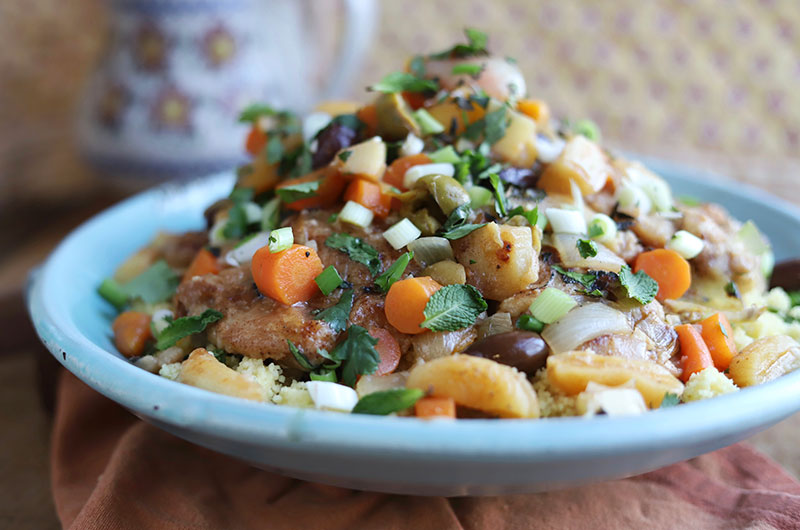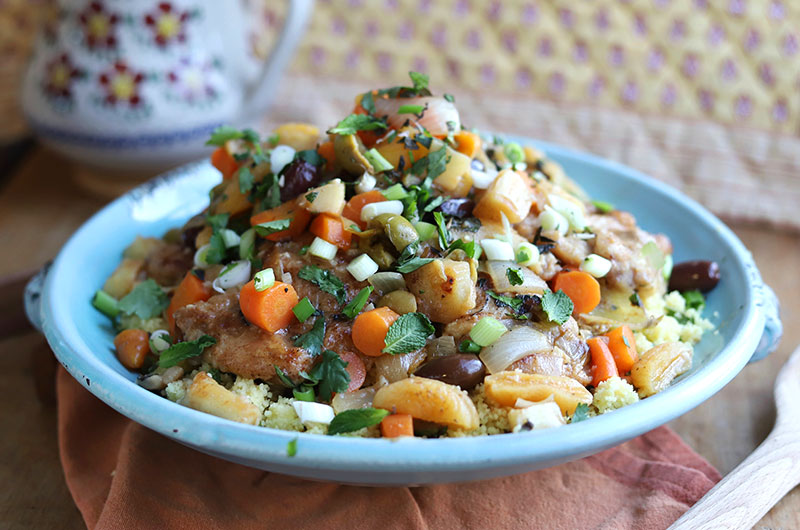In the spring of 2009, my wife Paula Lyons and I were up in Camden, Maine, to perform at the Opera House in the center of town. We were starting our 13th season of Says You!, the weekly NPR comedy quiz show (now going into its 25th season). For the duration of this series, we have been on the show’s panel as the married couple of longest standing.
So there we were in our sweet suite in a nearby boutique inn preparing ourselves for that day’s performance. As we were getting dressed, Paula switched on the television. Now, being the cook in the family, I keep my eyes, ears, and taste buds open for recipes at all times. While shaving in the bathroom, I began hearing words coming from the television: “Chicken thighs…dried apricots… Manzanilla olives…cinnamon…carrots and parsnips…on a bed of orange juice-infused couscous…” Sounds Moroccan, sounds intriguing, sounds delicious.
What I heard was a chef on a CBS morning show offering a recipe I surely needed to make once I got home. As I usually do with recipes, I played with it once I had found the ingredients online. Although I know that bone-in chicken breasts and thighs tend to have, if not more flavor, certainly more professional status, I happen to feel they’re clumsier to eat. For a more relaxed meal, I go with boneless.
Frankly you can start lots of good meals by braising boneless chicken thighs dredged in seasoned flour in an olive-oiled pan. It all depends on what you add next. In this case, you can really make a splash with dinner guests (or your family) when you stir in sliced dried apricots, green olives, and a few (or more than a few) dashes of cinnamon. If the taste isn’t exotic enough for the palate, wait till the orange-juiced couscous and a garnish of mint and scallions hit the senses.
Essentially, this dish is a flavorful stew, a plate of comfort food for a winter’s evening. I’ve made this at least a dozen times and each time, there are at least two guests that give me a slow moist-lipped grin and ask for seconds. And wherever I serve it, there’s a general feeling around the table that we’ve all been somehow transported to Casablanca. Of all the gin joints in all the towns in all the world, they’ve thankfully come into mine.
A final comment about cinnamon: There’s more than one kind. What’s called true cinnamon comes from the bark of an evergreen found in Sri Lanka (Ceylon) and India. Pungent and aromatic, it’s used more among the British. Americans are more used to a stronger and sweeter type that comes from the cassia tree in China and Southeast Asia.
The next time you find yourself in a Penzey’s spice shop (the nearest one is in Arlington, Mass.), check out their variety of cinnamons – Ceylon, China, Vietnamese and Korintje (West Sumatra) – and have yourself an olfactory fiesta. I use one of theirs that combines all four. (Thankfully, you can explore their cinnamons online, too.)
Shahiat tayiba! That’s how you’d say Bon Appetit! in Morocco.
Arnie Reisman is the author of three books of poetry.








